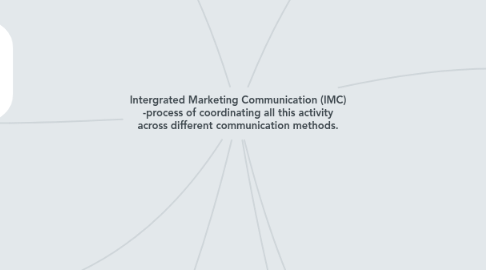
1. Importance of Teamwork
1.1. Save money
1.2. Save time
1.3. Save effort
1.4. Must be present a consistant coordinated promotional effort at every point of customer
1.5. Contact with the organization
2. Elements of Promotional Mix-subset of the marketing mix in which marketers attempt to achieve the optimal
2.1. Personal Selling
2.2. Nonpersonal Selling
2.2.1. Guerrilla Marketing
2.2.2. Public relation and Publicity
2.2.3. Sales Promotion
2.2.4. Direct Marketing
2.2.5. Advertising
2.2.6. Product Placement
3. Pulling & Pushing Promotion Strategies
3.1. Pulling
3.1.1. Promotional effort by the seller to stimulate final-user demand, which then exerts pressure on the distribution channel
3.2. Pushing
3.2.1. Promotional effort by the seller directed to members of themarketing channel rather than final users.Relies more heavily on personal selling.
4. Direct Marketing
4.1. Objective
4.1.1. Opens new international markets of unprecedented size.
4.1.2. Promotes goals beyond creating product awareness.
4.1.3. Increase store traffic
4.2. Direct malls
4.2.1. Sales letters, postcards, brochures,booklets,catalogs,house organs and DVDs.
4.3. Television and Radio
4.3.1. Home shopping channel and informercial.
4.4. Internet
4.4.1. Via email
4.5. Print Media
4.5.1. Newspaper &magazine
4.6. Electronic kiosks
5. Objectives of Promotion
5.1. 1.Provide information
5.2. 2. Increase demand
5.3. 3. Differentiate a product
5.4. 4. Accentuate a product's value
5.5. 5. Stabilize sales
6. Communication Process
6.1. Sender
6.2. Message
6.3. AIDA
6.4. Encoding
6.5. Decoding
6.6. Feedback
6.7. Noise
6.8. Channel
7. Sponsorship
7.1. Organizations provide money or in-kind resources to an event or activity in exchange for a direct association with that event or activity.
7.1.1. Sponsorship spending
7.1.2. Growth of Sponsorships
7.1.3. How sponsorship differs from advertising
7.1.4. Assessing sponsorship results
8. Measuring the effectiveness of Promotion
8.1. 1.Measuring online promotions
8.1.1. cost per impression
8.1.2. cost per response

